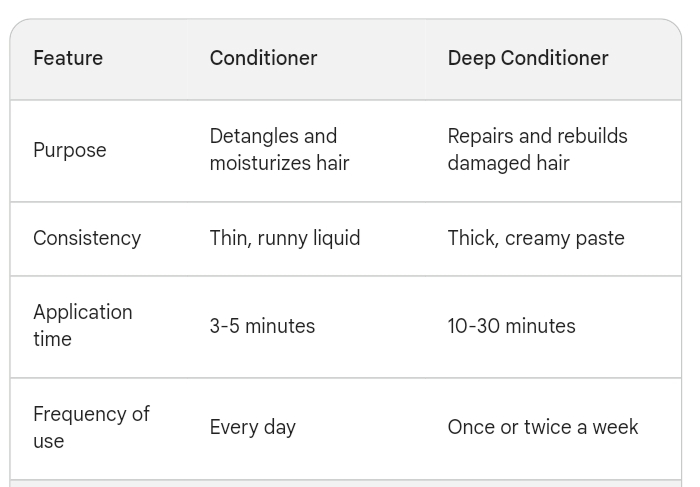Conditioning and deep conditioning are both important steps in a healthy hair care routine. However, there are some key differences between the two.
Regular conditioner is used to detangle, moisturize, and soften hair after shampooing. It typically has a thinner consistency than deep conditioner and is left on the hair for a shorter amount of time, usually around 3-5 minutes. Regular conditioner helps to replenish the moisture that is lost during shampooing and helps to make hair easier to manage.
Deep conditioner is a more intensive treatment that is designed to repair and restore damaged hair. It typically has a thicker consistency than regular conditioner and is left on the hair for a longer amount of time, usually 10-30 minutes. Deep conditioner contains ingredients that can penetrate the hair shaft and help to repair damage caused by heat styling, chemical treatments, or environmental factors.
Here is a table that summarizes the key differences between conditioning and deep conditioning:
Can I use regular conditioner as a deep conditioner?
You can use regular conditioner as a deep conditioner in a pinch, but it won't be as effective. Regular conditioner doesn't have the same ingredients or the same consistency as deep conditioner, so it won't be able to penetrate the hair shaft as deeply and won't provide as much benefit.
How often should I deep condition my hair?
The frequency of deep conditioning depends on your hair type and how often you heat style or color your hair. If you have healthy hair, you can deep condition once a week or once every two weeks. If you have damaged hair, you may need to deep condition more often.
Here are some tips for deep conditioning your hair:
Apply deep conditioner to clean, damp hair.
Leave the deep conditioner on for 10-30 minutes.
Use a heat cap or a towel to help the deep conditioner penetrate the hair shaft.
Rinse the deep conditioner out thoroughly.
Follow with a leave-in conditioner or styling product.
Deep conditioning is a great way to keep your hair healthy and strong. If you have damaged hair, deep conditioning can help to repair the damage and make your hair look and feel better.


Comments